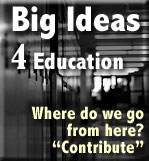I have been following David Warlick's "
Big Ideas For Education" project over at
2 Cents Worth and have found it quite engaging so far. If you have not seen this project or participated I encourage you to visit the project website and take a look. There are still two days left in Phase 3 where he asks bloggers to blog about the ideas participants from phase 1 and 2 came up with for recommendations to the President-Elect's Department of Education. The following is my reply:

Schools have pretty much been the same for 100+ years. Why have they not significantly changed when our world has? I believe we are nearing the dawn of an awakening and revolution in education. Some might argue it has already started to happen. Our public schools, and the compulsory education curriculum, were originally founded upon two main overt purposes: to produce an informed citizenry, and produce a productive workforce. One aim is chiefly Jeffersonian and the other Hamiltonian. Underlying both of these aims is a hidden goal to produce an obedient population. While all three of these goals have their merits, certainly it is better to be informed, productive, and lawful than ignorant, lazy, and criminal, there lies in these aims a basic flaw.
In an attempt to create an informed electorate a curriculum or group of standards must be developed. The people who write this curriculum have a lot of power to influence the thoughts and opinions of others. By choosing to show someone one thing or not show another our thoughts on a topic can be changed dramatically. Just look at the role of evidence in court cases. So, in an attempt to create an informed electorate our schools result in stifling free thought. Curriculum, even with it's best intentions, can be nothing more than state sponsored propaganda.
During both the industrial revolution and the ag-based economy that preceded it we needed workers who were productive and could follow instructions. Many of the mainstays of traditional education were very good at training students to become obedient, non-questioning, producers. Chief among these are our traditional notions of homework. Much of this homework was, and still is, simply busywork and does not effectively reinforce stated learning objectives. What it did and still does teach is the endurance to work through mindless tasks. This is a valuable skill if you work on an assembly line and have to spend all day following instructions from your boss or carrying out repetitive mindless tasks. However, most of those jobs are gone today. Writers like Daniel Pink, Thomas Friedman, and Clay Shirky all agree that what is needed in our workforce are creative thinkers. Any job that can be reduced to automation is either going to be replaced by software or it is going to be outsourced. This aim of producing a productive workforce has squashed the new need for a creative workforce.
This third aim of compulsory education of creating an obedient population is also problematic. While this aim has never been stated overtly, it is overwhelmingly apparent in how we structure our schools. Sit Down! Be Quite! Do Your Work! Our high school students follow a bell schedule, often sit in neatly ordered rows, and are forced to follow a set of rules meant to maintain an authoritative structure. These rules often are impediments to inquiry, free thought, and creativity. We do things like ban cell phones rather than use them to engage students in learning. We impose penalties for trite infringements like wearing a hat in class. And we stifle reflection and dialogue by maintaining that our classrooms need to be quiet. And what happens when a teacher, the pedagog, decides to bunk this system and promote inquiry, reflection, creativity, and free thought? The school removes the pedagog.
I believe we are on the cusp of a great awakening in education. School choice, differentiated instruction, homeschooling, online learning, alternative education, and the charter movement are all addressing the questions underlying what has been wrong with our traditional school system. Each addresses something different but all are important in the public discourse about what schools are for. All are disruptive innovations, as Clayton Christensen describes, that will cause the ultimate demise of our traditional public school system.
When the camera was invented the visual arts went through an identity crisis known to the art world as Modernism. Modernism was all about defining what art was. With the camera art was no longer necessary for simply creating images, the camera was much more efficient at that. The artist was not needed for the same reasons they were needed before. This identity crisis produced as many theories of art or art genres as there are theories of education. The information economy and flattened world, brought on by advances in both information technology and automation, is to public schooling what the camera was to art. Without having the same workforce needs we did in the past and with unlimited information at our fingertips we no longer really have any need for schooling as we have always known it.
Now, we are at a point where we need to do some serious reflection about what our education needs are in our country. What are schools for? What is the end product of schooling? What do we value? What do we need? It seems these last two questions are pivotal. Before, we needed schooling to produce workers for a production economy based entirely on infinite growth and citizens to support that economy. It seems that two issues facing our country are colliding here. One is public schooling but the other is the economy. Our economy is a mess right now. I believe this mess has been a direct result of the systems need to continually grow. How much do we really need? At what point do our needs erode our environment? Has our culture grown to value profit above happiness? As we work to address all of these issues we all need to take a deep look at ourselves and decide what is important. If we continue on the industrial economic paradigm projections show we will not be able to compete with other emerging superpowers like China and India. If we continue down this path we have been on we will ultimately loose that game but also pollute the Earth to the extent that quality of life issues will be physiological, not just psychological. Since we will be destroying our earth in the process, the economic game we have been playing is a zero sum end game.
How do you get out of a zero sum end game? Change the rules of the game. Change the reason for playing. Another product of the flat world is the assimilation of different cultural ideas. This might be our saving grace. There are cultures on this planet that have fundamentally different values. Bhutan, for instance, measures their national level of happiness and that is used to measure their success or failure, not monetary or material gains. Material possessions, levels of happiness, as well as the environment are aspects of our quality of life. Rather than focus on GDP (Gross Domestic Product) the change we need is a shift in our focus to GQL (Gross Quality of Life). Any education policy must address this. Education ought to enrich students, grow their curiosity, expand their minds, and foster their creativity. Support of charter schools, online education, alternative education, and homeschooling are all a step in the right direction.
People are waking up. The awakening is happening. Dropout rates are on the rise. Homeschooling is on the rise. Online schools have seen a 30% annual increase in enrollment for the past seven years. Charter schools are springing up everywhere. Teachers like Clay Burell are leaving school and pursuing an unschooly attitude toward education. All the while, our public schools are cutting programs that arguably contribute more toward GQL than what they are keeping in reaction declining enrollment.
Our national curriculum should not be a list of things we have to learn but rather an open curriculum that promotes inquiry. The arts, physical education, vocational programs, and extra curricular activities need more emphasis. Our schools must promote inquiry, honor free thought, foster creativity, and honor independence. Wake up! The awakening has begun. This revolution will not be televised, but it will be available on YouTube, Facebook, Flickr, Delicous, Twitter, Plurk, Myspace, Blogger, Wordpress, Vimeo, Blip.tv, Ustream.tv, and Google.






























